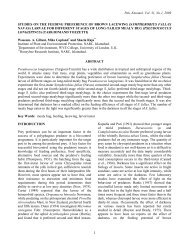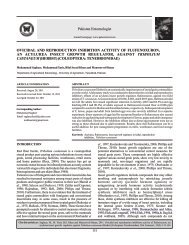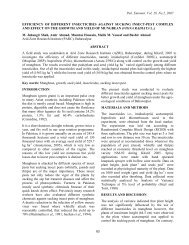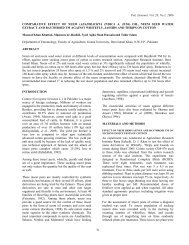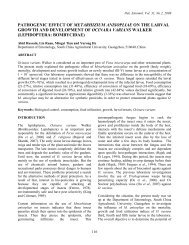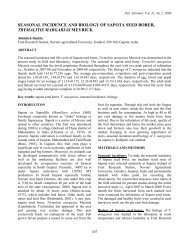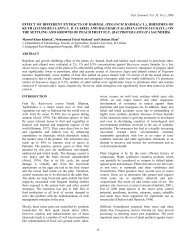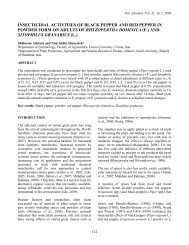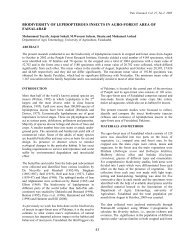Create successful ePaper yourself
Turn your PDF publications into a flip-book with our unique Google optimized e-Paper software.
Pak. Entomol. Vol. 26, No.1, 2004<strong>IMPACT</strong> <strong>ON</strong> BI<strong>ON</strong>OMICS <strong>OF</strong> <strong>Bombyx</strong> <strong>mori</strong> L. FED <strong>ON</strong>LEAVES SPRAYED WITH MINERAL SOURCESMuhammad Aslam and Muhammad AshfaqDepartment of Agri. Entomology, University of Agriculture, Faisalabad.ABSTRACTSilkworm rearing on Morus laevigata L., mulberry leaves sprayed with recommendeddoses of mineral sources revealed that mulberry leaves sprayed with 0.2 N + 0.1% P + 0.3%K + 0.1% Ca + 0.1% Mg + 0.15% Zn + 0.05% Cu + 0.1% Fe + 0.15% Mn proved better interms of moth eclosion, crumpled wing individual, mating duration adult life spanFemale/male as well as fecundity and hatching percentage of the eggs laid by the femalemoth in addition to the cocoon yield.INTRODUCTI<strong>ON</strong>The raw silk which is the dry salivary secretionof the silkworm is known as golden fibre or thegolden queen of the textile. The world wide increasein demand for the raw silk from 1960-70 was 2.5%per annum in the international market (Lian andFual, 1991). The total demand of the raw fabrics inthe world is 6000 crores (Hiware, 2001).The dietary deficiencies, resulting frominadequate amount of nutrients in the food, impairgrowth moulting body form, as well as havedetrimental effects on reproduction (Chap man,1975).Chakrabarti and Medda (1978) reported theeffect of potassium iodide on the development of<strong>Bombyx</strong> <strong>mori</strong> L. and other aspects of silkwormrearing by offering mulberry leaves soaked in thesolution of potassium iodide @ 20 g/ml to silkwormlarvae and found more no. of eggs laid than thosefed on leaves soaked in distilled water. Thangaveluand Bani (1990) found the effect of trace amount ofminerals (Ca, Mg, Fe) and their salts present inrainwater. They concluded that minerals and theirsalts stimulated the metabolic activity of thesilkworm, resulted short larval duration and increasein effective rearing rate. Moreover, an increase ofmore than 100 eggs per laying and 2.4% silk ratio.Rav et al. (1998) described that in order toexploit high yield potential of the bivoltine hybrid of<strong>Bombyx</strong> <strong>mori</strong> L., P 5 × KPG (β), different levels ofplant nutrition and sources combinations of N.P.M,80:40:40 kg/ha per pruning, when fed to the 5 thinstar larvae the larval growth, productivity, cocoonquality and fecundity and survival rates of silkwormincreased in adverse conditions.Rearing of silkworm larvae was carried out inEntomological Laboratories, University ofAgriculture, Faisalabad.MATERIALS AND METHODSAfter cocoon formation 20 cocoons wereselected from each lot at random and were kept in agrainage tray I in a single layer in the laboratory at25 ± 1°C and 75 ± 2% R.H. to study the bionomicsi.e., moth eclosion percentage crumpled wingindividuals, mating duration, adult life span (femaleand male), number of eggs laid per female and theviability of the eggs. The moth eclsoion wascalculated as under:Number of pierced cocoonsMoth eclosion = ----------------------------------- × 100Total number of cocoonsWhereas crumpled winged individual wascalculated by the following formula:39
Pak. Entomol. Vol. 26, No.1, 2004Number of C.W. MothsC.W.I. = --------------------------------- × 100Total number of mothsThe fecundity and hatching percentage was noted byvisual counts.RESULTS AND DISCUSSI<strong>ON</strong>The statistically analyzed data presented in(Table 1) indicate significant differences in testparameters among treatments during post cocoonlife of the silkworm, <strong>Bombyx</strong> <strong>mori</strong> L. The maximummoth eclosion percentage recorded was 77.41%where the mulberry leaves were sprayed over with0.2% N + 0.1% P + 0.3% K + 0.1% Ca + 0.1% Mg+ 0.15% Zn + 0.05% Cu as well as 0.1% Fe and0.15% Mn and minimum 53.89% in control, whereuntreated mulberry leaves were fed to the silkwormlarvae. The moth eclosion was 76.48% in T 8 whichwas statistically at par with T 9 and differsstatistically from rest of the treatments however, anopposite trend was recorded in case of %age ofcrumpled wing individual per treatment. Thedeformed/tilted winged %age was maximum (8.25)in T 0 as compared to the only 0.23% in T 9 . In T 8C.W. Individuals were 0.47% which was alsosignificantly different from rest of the treatments butstatistically at par with T 9 . The mating duration (7hours), adult life span female/male (8.25 days),(7.81 days), fecundity 450.20 eggs/female and 89.07hatching percentage were recorded maximum in T 9which were at par statistically with T 8 and differsstatistically from rest of the treatments.Table 1: A multiple comparison of the mean-values of different nutritional treatments (Ts)on various developmental and productive potentials of silkwrom <strong>Bombyx</strong> <strong>mori</strong> L. at25 ± 2°C.TreatmentsMothEclosion (%age)C.W.Individuals (%age)MatingDuration (h.)A. Life Span(F) (days)A. Life SpanM) (days)Fecundity(ns.)Hatching(%age)T 053.89 h **8.25 a **2.75 h **4.22 i **3.87 g **223.00 h **61.30 h **T 158.33 g4.47 b3.57 g5.18 h4.49 f254.00 g66.11 gT 261.30 f3.60 bc4.20 f5.90 g5.05 e287.20 f70.56 fT 363.70 e2.86 bcd4.72 e6.27 f5.63 d322.60 e75.07 eT 467.04 d2.26 cde5.48 d7.05 e6.48 c360.00 d80.30 dT 569.63 c1.63 cde5.77 cd7.35 d6.75 bc384.50 c82.89 cT 670.93 bc1.86 cde6.01 bc7.63 cd6.96 b397.80 b85.11 bT 772.59 b1.32 de6.24 b7.87 bc7.07 b406.50 b86.04 bT 876.48 a0.47 e6.85 a8.07 ab7.57 a446.20 a88.37 aT 977.41 a0.23 e7.00 a8.25 a7.81 a450.20 a89.07 aT 0 control; T 1 , 2% N; T 2 , T 1 + 0.1% P; T 3 , T 2 + 0.3% K; T 4 , T 3 + 0.1% Ca; T 5 , T 4 + 0.15% Mg; T 6 , T 5 +0.15%Zn; T 7 , T 6 + 0.05% N Cu; T 8 , T 7 + 0.1% Fe; T 9 , T8 + 0.15% Mn.40
Pak. Entomol. Vol. 26, No.1, 2004Our findings are quite in line with Ashfaq etal. (1998) and Ashfaq et al. (2001) who found thatwhen mulberry leaves dipped in the recommendeddoses of minerals they did not only influenced thelarval growth and development but also thefecundity of the female moth. These results werein close contact with Chakrabati and Medda(1978), who obtained similar results after rearingthe silkworm on the mulberry leaves treated withthe solution of potassium iodide @ 20 g/ml. Theresults are in agreement with the results obtainedby Trhanga velue and Bania (1990), who used theCa, Mg and Fe in their experiment. These findingsare to indirect conformity of the results of the Ravet al. (1998) who studied the role of majornutritional elements like N, P, K @ 80:40:40 kg/haper pruning, so it is concluded that spraying ofmacro and micro-nutrients on the mulberry leavesimproves not only the cocoon yield but alsoexpedite the other life processes of the silkworm,<strong>Bombyx</strong> <strong>mori</strong> L. The moths cannot feed and rest ofthe life activities depend upon the food consumedand utilized during entire larval life.REFERENCESAshfaq, M. and A.A. Sial, 2001. The effect ofoptimum doses of mineral nutrients N,P,K,Ca, Mg and Cu in various combinationsthrough rest supplementation on the larvaldevelopment and silk yield of <strong>Bombyx</strong> <strong>mori</strong> L.Pak. Entomol., 23(1-2): 103-106.Ashfaq, M., N. Ahmed and A. Ali, 1998. Effect ofoptimum doses of Nitrogen, Potassium,Calcium and Copper on silkworm, B. <strong>mori</strong> L.development and silk yield. South PacificStudy, 18(2): 47-50.Chakrabarti, M. K. and A.R. Medda, 1978. Effectof potassium iodide on <strong>Bombyx</strong> <strong>mori</strong> L.Nistari race. Sci. Cult., 44(5): 231-233.Chapman, R.F., 1975. The Insect Structure andFunction: Nutrition. English Uni. Press Ltd.,London, U.K. 70-82 pp.Hiware, C.J., 2001. Agro Cottage Industry,Sericulture: Introduction and History ofsericulture. Daya Publishing House Delhi,India. pp. 1-4.Lian, Y.L and L. Fual, 1991. Silkworm rearing.Agric. Services Bull., Food Agric. Org.,Rome, Italy, 1: 1-5.Rav, N., J. Ghosh and S.K. Sanapati, 1998.Combined effect of fertilizer levels andsucrose on rearing performance of bivoltinesilkworm, <strong>Bombyx</strong> <strong>mori</strong> L., at Terai region ofWest Bangal. Environ. Ecol., 16(1): 108-112.Thangavelu, K. and H.R. Bania, 1990. Preliminaryinvestigation on the effect of minerals in therain water on the growth and development ofsilkworm, <strong>Bombyx</strong> <strong>mori</strong> L. Ind. J. Seric.,29(1): 37-43.41



